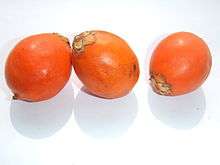Astrocaryum vulgare
| Astrocaryum vulgare | |
|---|---|
 | |
| Atrocaryum vulgare | |
| Scientific classification | |
| Kingdom: | Plantae |
| (unranked): | Angiosperms |
| (unranked): | Monocots |
| (unranked): | Commelinids |
| Order: | Arecales |
| Family: | Arecaceae |
| Genus: | Astrocaryum |
| Species: | A. vulgare |
| Binomial name | |
| Astrocaryum vulgare Mart. | |
| Synonyms | |
| |
Astrocaryum vulgare (common names Tucum or Tucumã-do-Pará in Brazil, Aouara in French Guiana, Wara awara in Guyana, awarra in Suriname, Chontilla in Ecuador) is a palm native to Amazon Rainforest vegetation, typical of the Pará state in Brazil. This plant has edible fruit, which are also used for biodiesel production. This plant is cited in Flora Brasiliensis by Carl Friedrich Philipp von Martius. This species is native to the Amazonian region, possibly to the state of Pará, where it has its center of distribution, and reaches French Guiana and Suriname. It is a characteristic palm of terra firme, low vegetation cover, or even open fields. The tree is 10 to 15 m in height and regenerates easily by growing multiple stems. The tucumã palm is considered a pioneer plant of aggressive growth, has the ability to grow new shoots after a fire, and mainly inhabits secondary forests and pastures. Seeds take up to 2 years to germinate, the plants grow slowly in cultivation, and start to produce fruits after eight years. Its resistance to diseases and high productivity make this species an alternative for the production of biodiesel, since the operating costs of an orderly plantation is much less than that of the oil palm.[1]

The seed is covered externally with an orange oily pulp. On average, the fruit weighs 30 g; 34% of this weight corresponds to the external pulp that has 14% to 16% of the oil when it is raw. A mature tree can produce up to 50 kg of fruits per year (25 kg per tree on average), which corresponds to 2.5 kg of pulp oil and 1.5 kg of seed oil. In one hectare, 400 palm clusters can be planted, each cluster with three trunks. In total, this equals 1200 palm trunks and will result in 4.8 tons of fatty material per hectare. Iit forms clusters that do not need to be replanted.[1]
Oil
The fruit is composed of a woody core almost black color, containing a white almond paste, oilseed, very hard and covered with a yellow-orange pulp, little consistency and oily. Two types of oils are produced by this fruit: the oil of external pulp and almond oil. The oil is found in the fruit, as follows.[2]
The tucum ring
The seed in the fruit is notably used by indigenous Amazonians to make black rings. In the 1800s, this ring was used as a symbol of marriage for the slaves and natives, who could not afford to purchase gold. In addition, the ring was also a symbol of friendship and of resistance to the established order – the freedom fighters. Now these rings are worn by Catholic missionaries as a symbol of solidarity with the poor and support in the struggle for equality, social justice and human rights.[3][4][5][6][7]
-

Fruits of Astrocaryum vulgare
-

Seeds
References
- 1 2 Morais, Luiz Roberto Barbosa Química de oleaginosas : valorização da biodiversidade amazônica = Chemistry of vegetable oils : valorization of the amazon biodiversity. — Belém, PA : Ed. do Autor, 2012. — (Oleaginosas). CDD-633.850981
- ↑ PESCE, Celestino. Oleaginosas da Amazônia. –Belém: Museu Paraense Emilio Goeldi, 2009.334 p.: il. ISBN 978-85-61377-06-9 (MPEG) e 978-85-60548-39-2 (MDA).
- ↑ Story of the Tucum ring « Brazil
- ↑ 'O Anel De Tucum' (1994) Conrado Berning, 70 mins in Português,Verbo Filmes
- ↑ Eneida Duarte Gaspar 'O Caminho da cruz' 2001 (ISBN 8534702969)
- ↑ en.tucum.org - Ceará’s Community Tourism Network receives the To Do! Award in Berlin
- ↑ our ring
- Schultes, Richard E. (1974). Palms and religion in the northwest Amazon. Principes 18 (1): 3-21.
- (Portuguese) Freitas, C. O.; Silva, M. M., Silva, I. Q., Rodrigues, A. M. C. Características Físicas da Oleaginosa Tucumã (Astrocaryum vulgare Mart.)
External links
- Astrocaryum vulgare photo of fruit
- Astrocaryum vulgare
- (Portuguese) Flora Brasiliensis: Astrocaryum vulgare